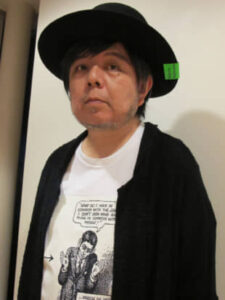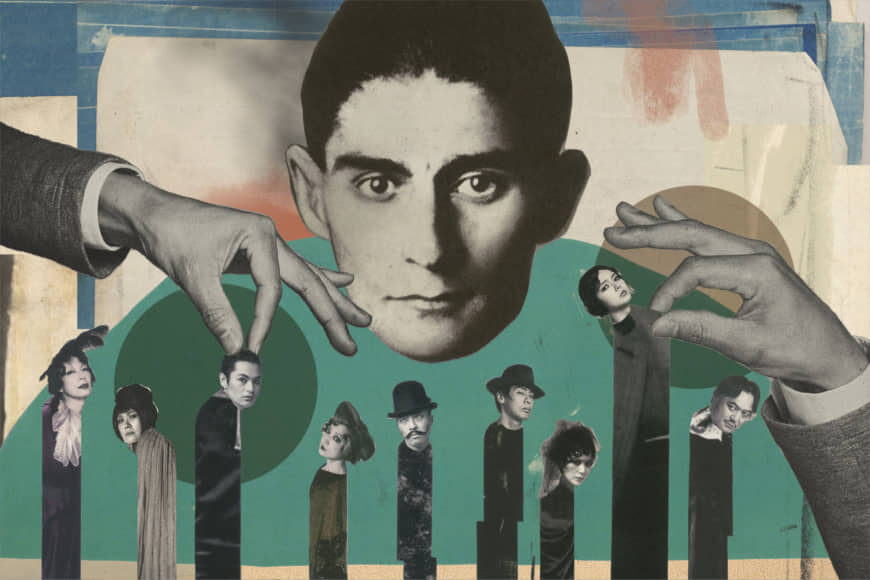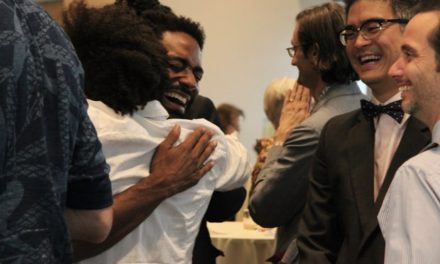The starting point for Dr. Hoffmann’s Sanatorium was, according to the play’s Japanese creator, Keralino Sandorovich, the idea that “someone found an unpublished novel by the great Franz Kafka“; Referring of course to the Prague-born author whose works are filled with themes of all-consuming paranoia and nonsensical oppression. The Metamorphosis, his 1915 novella begins with: “When Gregor Samsa woke up one morning from unsettling dreams, he found himself changed in his bed into monstrous vermin”, which embodies this clearly. It’s perhaps not the sort of thing everyone would find inspirational but for Sandorovich, an award-winning playwright, and theater and film director, this latest production marks his third foray into Kafka’s life and works.
Nylon 100°C Theater
Their first production was 2001’s hilarious semi-biographical Kafka’s Dick. Then came Setagaya Kafka in 2009, in which each of the protagonists of the three known full-length novels Kafka wrote (Amerika/The Man who Disappeared, The Trial, and The Castle) appeared alongside Kafka himself. All four were, however, transformed into Japanese characters living in today’s trendy Setagaya neighborhood in Tokyo.
Now a decade later, Sandorovich (also named Kazumi Kobayashi) has come up with a storyline in which someone discovers a fourth, unpublished full-length novel by the haunting, and seemingly haunted writer entitled A 4th Long Piece by Kafka. This title doesn’t hint at the nightmarish nature of that novel as the play describes it, or the disturbing way in which its finder (played by Ikkei Watanabe), and his mysterious friend (played by Koji Okura), try to sell it in the present day; slipping occasionally back to Kafka’s time. Indeed, they even visit Dr. Hoffmann’s Sanatorium — the quarantine hospital outside Vienna where the author died in 1924 at the age of 40, after contracting tuberculosis.
Kera and Kafka

Keralino Sandorovich, Director and Playwright of Dr. “Hoffmann’s Sanatorium”. November 2019. Photo Credit: Nobuko Tanaka
Pointing to his one-off Kafka T-shirt as we sit down for a chat, 56-year-old Sandorovich or “Kera,” as the one-time indie-rocker known for his dry sense of humor, is generally known, chuckles. “I don’t know why I love Kafka’s world so much,” he says. “He wasn’t a professional author and only a few of his writings were published while he was alive, although there are a huge number of books about him on sale these days. I’m sure that an anonymous worker at an insurance company in Prague never imagined (becoming) this phenomenon.”
Sandorovich goes into detail why he holds Kafka in such high regard: “Firstly, I respect him as he continued writing, even in such a hopeless situation. Also, I think there was no calculated intention behind his writing; he described things as he saw them and I suppose society just seemed so absurd to him. I like that straightforwardness. He devoted his life to creative writing without ever getting married, though he had various close female friends.” Sandorovich adds that he has come to be more and more interested in the author’s eccentric character and events in his life, as well as being influenced by studying his novels and letters. “I read how Kafka once told his friend Max Brod (who compiled and published many of his works, including those three long novels from unfinished manuscripts he found after Kafka’s death, despite being told to burn them all), that writing to him was like wandering about in a dark tunnel” Sandorovich says. “Because of that, he explained, the characters and even himself, the author could never see the other end of the tunnel before reaching the end.”
The Company in Rehearsal
Sandorovich, who founded the Tokyo-based Nylon 100°C theater company, says he feels something in common with Kafka. “I understand entirely because I normally write my plays in the same way,” he says. “I just start and follow the flow; I don’t map out a plot at the beginning.” Kafka’s novels all stop without a real ending, whereas Sandorovich has to not only finish his plays but stage them, too. However, he is known for often writing until just before the curtains rise at his plays’ premieres.
When we meet in the middle of rehearsals, he admits he is still polishing and adding to the script in light of how the actors are performing and the new ideas he is gaining from them. So, the actors themselves are a crucial part of his writing. “I know I trouble the actors and the company a lot with my writing delays, but, on the other hand, that pressure is great for getting me to create my best work for them,” he says.
Inspiration Behind The Works
“I always keep it in mind to have the spirit of (Steven) Spielberg and Nouvelle Vague in my plays; Both entertainment and art elements coexist in them,” Sandorovich says with a laugh. “I don’t want to lean to one side or the other, serious or funny, I want to have both.” Sandorovich says he takes his inspiration from a range of places and genres. “Basically, I prefer British black comedy to American safe comedy,” he says. “I especially don’t like simple, pass-mark entertainment, and much prefer abstruse works such as the films of Ingmar Bergman, Federico Fellini, and Andrei Tarkovsky.”
Kafka Beyond Dr. Hoffmann
Corresponding with his taste in films, many of Sandorovich’s plays that don’t mention Kafka are nonetheless ‘kafkaesque’ in style. For instance, in his award-winning 2016 comedy, Kinema to Koibito (Cinema and Lovers) — which he has admitted was inspired by Woody Allen’s 1985 hit The Purple Rose of Cairo — the movie-actor hero of a young woman, whose only pleasure in life is watching him at the cinema, suddenly steps out from a film being projected on the stage and immediately falls in love with her; while in 2008’s Shapu-san Furatto-san (Mr. Sharp and Mr. Flat), events from a fictional drama appear in the real world and its characters talk to the work’s playwright protagonist.
“People used to enjoy such ‘kafkaesque’ artworks as imaginative creations, but I feel our real world has got more and more like that, and a lot of the news sounds exactly ‘kafkaesque,’” Sandorovich says. “I feel uneasy about today’s situation.”
Hopes for the Future
The prolific playwright says he also regards what he sees as today’s excessive control over arts and theater as being dangerous. “Once artists become frightened of other people’s moral judgments or critical voices from different social or political backgrounds, then all the arts immediately become weak and fall into ruin,” he says. “I feel the same level of danger in today’s society as the strong winds of nationalism in the prewar period. Yet, despite an obscure sense of crisis I feel over freedom of expression, my hope rests with the rising younger generation. I believe their opinions are much more reasonable than those of many of the older generations, including my own, and I think their ways will become the new standard.”
Dr. Hoffmann’s Sanatorium on stage
The most its creator would reveal in any detail about his staging of Dr. Hoffmann’s Sanatorium was to allow a brief peek into the rehearsal studio as he was busily directing the cast’s movements down to the second; It appeared, to mystify his audiences and spur their imaginations in ways they may not have thought possible. Actors went up and down the set dominated by labyrinthine arrangements of stairs. Kosuke Suzuki’s (a Japanese actor) live band of trumpet, percussion, and guitar added a central European flavor to it all, and I found I was already asking myself where Sandorovich’s wanderings in this dark tunnel would finally lead.
All will be revealed at Kanagawa Arts Theatre this month.
Dr. Hoffmann’s Sanatorium ran through Nov. 24 at Kanagawa Arts Theatre. It then traveled to Hyogo, Fukuoka and Aichi prefectures through Dec. 22. For more info click here.
This article was originally posted at TheJapanTimes and has been reposted with permission. To read the original article, click here
This post was written by the author in their personal capacity.The opinions expressed in this article are the author’s own and do not reflect the view of The Theatre Times, their staff or collaborators.
This post was written by Nobuko Tanaka.
The views expressed here belong to the author and do not necessarily reflect our views and opinions.


















